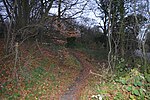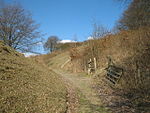Sallowsprings
Nature reserves in BedfordshireWildlife Trust for Bedfordshire, Cambridgeshire and Northamptonshire reserves

Sallowsprings is a 1.3-hectare (3.2-acre) nature reserve in Whipsnade in Bedfordshire. It is managed by the Wildlife Trust for Bedfordshire, Cambridgeshire and Northamptonshire.This site was formerly a caravan park, and it is now a traditional hay meadow. A rich variety of flowers includes common knapweed, bluebells and cowslips. An ancient hedgerow has a variety of shrubs such as holly.There is access from the road called Sallowsprings.
Excerpt from the Wikipedia article Sallowsprings (License: CC BY-SA 3.0, Authors, Images).Sallowsprings
Bushey Close,
Geographical coordinates (GPS) Address Nearby Places Show on map
Geographical coordinates (GPS)
| Latitude | Longitude |
|---|---|
| N 51.8546 ° | E -0.5371 ° |
Address
Whipsnade Tree Cathedral
Bushey Close
LU6 2LQ
England, United Kingdom
Open on Google Maps










